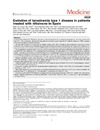Identificador persistente para citar o vincular este elemento:
https://accedacris.ulpgc.es/jspui/handle/10553/69418
| Título: | Evolution of tyrosinemia type 1 disease in patients treated with nitisinone in Spain | Autores/as: | Luz Couce, Maria Sanchez-Pintos, Paula Aldamiz-Echevarria, Luis Vitoria, Isidro Navas, Victor Martin-Hernandez, Elena Garcia-Volpe, Camila Pintos, Guillem Peña Quintana, Luis Hernandez, Tomas Gil, David Sanchez-Valverde, Felix Bueno, Maria Roca, Iria Lopez-Ruzafa, Encarna Diaz-Fernandez, Carmen |
Clasificación UNESCO: | 32 Ciencias médicas 3209 Farmacología |
Palabras clave: | Nephrocalcinosis Phenotype Severe liver dysfunction Tubulopathy Tyrosine |
Fecha de publicación: | 2019 | Publicación seriada: | Medicine | Resumen: | Treatment with nitisinone (NTBC) has brought about a drastic improvement in the treatment and prognosis of hereditary tyrosinemia type I (HT1). We conducted a retrospective observational multicentric study in Spanish HT1 patients treated with NTBC to assess clinical and biochemical long-term evolution.We evaluated 52 patients, 7 adults and 45 children, treated with NTBC considering: age at diagnosis, diagnosis by clinical symptoms, or by newborn screening (NBS); phenotype (acute/subacute/chronic), mutational analysis; symptoms at diagnosis and clinical course; biochemical markers; doses of NTBC; treatment adherence; anthropometric evolution; and neurocognitive outcome.The average follow-up period was 6.1 ± 4.9 and 10.6 ± 5.4 years in patients with early and late diagnosis respectively. All patients received NTBC from diagnosis with an average dose of 0.82 mg/kg/d. All NBS-patients (n = 8) were asymptomatic at diagnosis except 1 case with acute liver failure, and all remain free of liver and renal disease in follow-up. Liver and renal affectation was markedly more frequent at diagnosis in patients with late diagnosis (P < .001 and .03, respectively), with ulterior positive hepatic and renal course in 86.4% and 93.2% of no-NBS patients, although 1 patient with good metabolic control developed hepatocarcinoma.Despite a satisfactory global nutritional evolution, 46.1% of patients showed overweight/obesity. Interestingly lower body mass index was observed in patients with good dietary adherence (20.40 ± 4.43 vs 24.30 ± 6.10; P = .08) and those with good pharmacological adherence (21.19 ± 4.68 vs 28.58 ± 213.79).intellectual quotient was ≥85 in all NBS- and 68.75% of late diagnosis cases evaluated, 15% of which need pedagogical support, and 6.8% (3/44) showed school failure.Among the 12 variants identified in fumarylacetoacetate hydrolase gene, 1 of them novel (H63D), the most prevalent in Spanish population is c.554-1 G>T.After NTBC treatment a reduction in tyrosine and alpha-fetoprotein levels was observed in all the study groups, significant for alpha-fetoprotein in no NBS-group (P = .03), especially in subacute/chronic forms (P = .018).This series confirms that NTBC treatment had clearly improved the prognosis and quality of life of HT1 patients, but it also shows frequent cognitive dysfunctions and learning difficulties in medium-term follow-up, and, in a novel way, a high percentage of overweight/obesity. | URI: | https://accedacris.ulpgc.es/handle/10553/69418 | ISSN: | 0025-7974 | DOI: | 10.1097/MD.0000000000017303 | Fuente: | Medicine [ISSN 0025-7974], v. 98 (39), e17303 |
| Colección: | Artículos |
Citas SCOPUSTM
21
actualizado el 08-jun-2025
Citas de WEB OF SCIENCETM
Citations
18
actualizado el 08-jun-2025
Visitas
87
actualizado el 16-sep-2023
Descargas
110
actualizado el 16-sep-2023
Google ScholarTM
Verifica
Altmetric
Comparte
Exporta metadatos
Los elementos en ULPGC accedaCRIS están protegidos por derechos de autor con todos los derechos reservados, a menos que se indique lo contrario.
